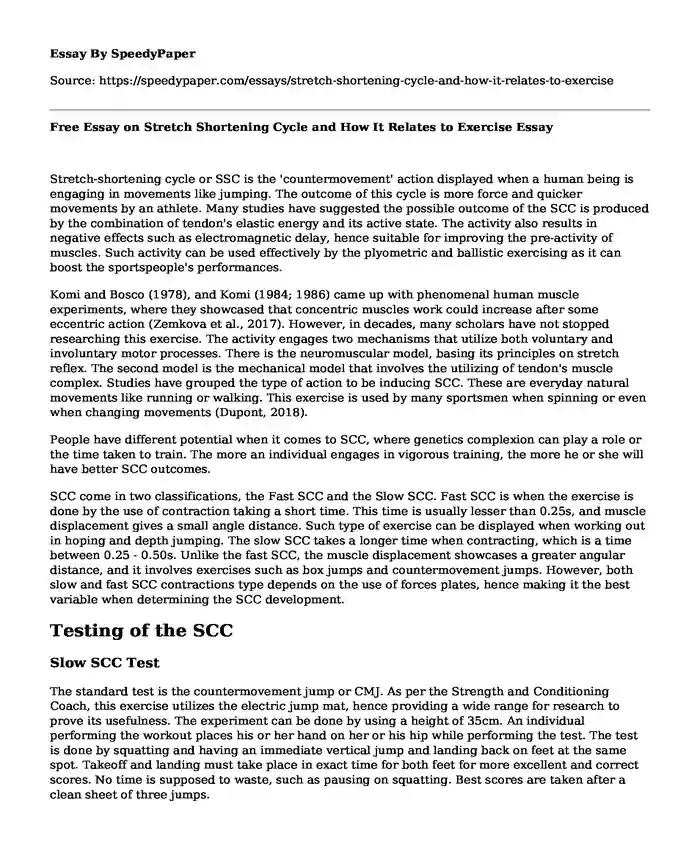
| Type of paper: | Case study |
| Categories: | Sport Healthcare |
| Pages: | 3 |
| Wordcount: | 751 words |
Stretch-shortening cycle or SSC is the 'countermovement' action displayed when a human being is engaging in movements like jumping. The outcome of this cycle is more force and quicker movements by an athlete. Many studies have suggested the possible outcome of the SCC is produced by the combination of tendon's elastic energy and its active state. The activity also results in negative effects such as electromagnetic delay, hence suitable for improving the pre-activity of muscles. Such activity can be used effectively by the plyometric and ballistic exercising as it can boost the sportspeople's performances.
Komi and Bosco (1978), and Komi (1984; 1986) came up with phenomenal human muscle experiments, where they showcased that concentric muscles work could increase after some eccentric action (Zemkova et al., 2017). However, in decades, many scholars have not stopped researching this exercise. The activity engages two mechanisms that utilize both voluntary and involuntary motor processes. There is the neuromuscular model, basing its principles on stretch reflex. The second model is the mechanical model that involves the utilizing of tendon's muscle complex. Studies have grouped the type of action to be inducing SCC. These are everyday natural movements like running or walking. This exercise is used by many sportsmen when spinning or even when changing movements (Dupont, 2018).
People have different potential when it comes to SCC, where genetics complexion can play a role or the time taken to train. The more an individual engages in vigorous training, the more he or she will have better SCC outcomes.
SCC come in two classifications, the Fast SCC and the Slow SCC. Fast SCC is when the exercise is done by the use of contraction taking a short time. This time is usually lesser than 0.25s, and muscle displacement gives a small angle distance. Such type of exercise can be displayed when working out in hoping and depth jumping. The slow SCC takes a longer time when contracting, which is a time between 0.25 - 0.50s. Unlike the fast SCC, the muscle displacement showcases a greater angular distance, and it involves exercises such as box jumps and countermovement jumps. However, both slow and fast SCC contractions type depends on the use of forces plates, hence making it the best variable when determining the SCC development.
Testing of the SCC
Slow SCC Test
The standard test is the countermovement jump or CMJ. As per the Strength and Conditioning Coach, this exercise utilizes the electric jump mat, hence providing a wide range for research to prove its usefulness. The experiment can be done by using a height of 35cm. An individual performing the workout places his or her hand on her or his hip while performing the test. The test is done by squatting and having an immediate vertical jump and landing back on feet at the same spot. Takeoff and landing must take place in exact time for both feet for more excellent and correct scores. No time is supposed to waste, such as pausing on squatting. Best scores are taken after a clean sheet of three jumps.
Fast SCC Test
The fast SCC can be done by the use of the Reactive Strength Index (RSI) Test. This test means the reactive strength equals the electric SCC potential. This test monitors the ability of how quick an athlete can change to a concentric form an eccentric contraction. The analysis also assesses how an athlete is able is to evolve minimal force by showcasing slightest ground contact time. Athletes can conduct RSI by jumping from an electric jump mat to a box. RSI is then calculated as the ratio of the time taken, and distance is taken for a complete clean jump. Time and distance are variables in this test and are worth to be considered when coming to the overall scoring. An electronic mat is used to come up with the time taken to contact the ground. Consequently, the time is calculated per the athlete "flight time."
SCC has showcased a more significant boost to the athletes who engage in ballistic and plyometric exercises. However, coaches are recommended to conduct the above-described test to realize the power and power deficit their athletes have. These tests will help them recognize the type of strengths each athlete needs to develop.
References
Dupont, D. (2018, January 15). Using the Stretch Shortening Cycle for Improved Efficiency. Retrieved from https://breakingmuscle.com/fitness/using-the-stretch-shortening-cycle-for-improved-efficiency
Zemkova, E., Vilman, T., Cepkova, A., Uvacek, M., Olej, P., & Simonek, J. (2017). Enhancement of power in the concentric phase of the squat and jump: Between-athlete differences and sport-specific patterns.
Cite this page
Free Essay on Stretch Shortening Cycle and How It Relates to Exercise. (2023, Mar 05). Retrieved from https://speedypaper.com/essays/stretch-shortening-cycle-and-how-it-relates-to-exercise
Request Removal
If you are the original author of this essay and no longer wish to have it published on the SpeedyPaper website, please click below to request its removal:
- New Deal Liberalism
- Mezzo Social Work Practices - Essay Sample
- Essay Example on Essential Public Health Services
- Art Essay Sample: Concept Art of Thief
- Hospitality in Hongqiao NECC - Free Example of Literature Review
- Article Review Essay: Stereotypes and Self-Perceptions of Physical Education Pre-Service Teachers
- Free Essay. Factors That Influence Quality, Safe, Patient-Centered Care
Popular categories




